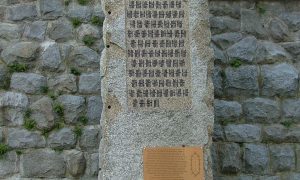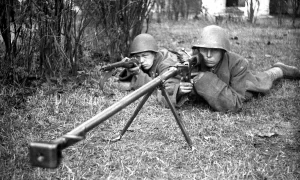This book is titled “Scars of the Siege” and is focused on major strikes and locations that were captured on camera during the siege itself.
It is an excellent look into the battle and we highly recommend it for anyone who would like to learn about the battle. If anyone would like a copy please don’t hesitate to reach out.
The following are excerpt from an excellent book about the Siege of Leningrad. By many records it is the Largest and costliest siege in recorded history.
The Full Book Has Many More Entries:
Authors: BAIR IRINCHEEV and SERGEY LARENKOV
Image 1: Map of Locations of major artillery and air strikes on Leningrad during the Siege of Leningrad 1941-1944.

map of artillery strikes in leningrad
“The reports were submitted to Leningrad Air Defence HQ the morning after an air raid occurred. It was not possible to clear all debris of collapsed buildings during one night, thus the number of wounded and killed civilians was definitely higher than what was stated in daily reports. Demolished buildings and shelters blocked by debris in the Gostiny Dvor department store took several days to clear. It is worth stressing that all casualties mentioned in the reports are civilian. Military personnel were always listed separately. According to summarized report from 1945, a total of 16,747 civilians died in the city due to German air raids and artillery bombardment over the three years of the Siege. 33,782 civilians were wounded. This guidebook does not comprehen-sively cover the topic of damage caused to the city of Leningrad. Its purpose is to make people reflect once more what a terrible test of human endurance the Siege of Leningrad was. We encourage you to recall the tremendous work of Soviet workers, engineers and architects who restored our city — one of the most beautiful cities in the world. In this guidebook collages by Sergey Larenkov vividly demonstrate how the city center looked during the Siege”
Image 2: 85mm – Anti-Aircraft Positions- Located on “Field of Mars”.
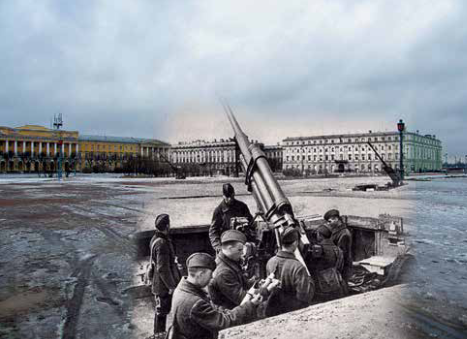
A 85 MM AA-GUN BATTERY ON REVOLUTION VICTIMS FIELD (NOW FIELD OF MARS) Heavy 85 mm AA-guns were placed on the Revolution Victims Field, on Decembrists’ Square, on Split of Vasilievski Island and University Embankment. Defensive fire of AA-guns prevented well-aimed drop of bombs. However, splinters of rounds of AA-artillery were dangerous for those who were in the streets. For this reason, militia and MPVO personnel demanded the civilians to take cover at least in the gateways or doorways during air raids and artillery bombardments.
Image 3: Medics Rush to the Scene
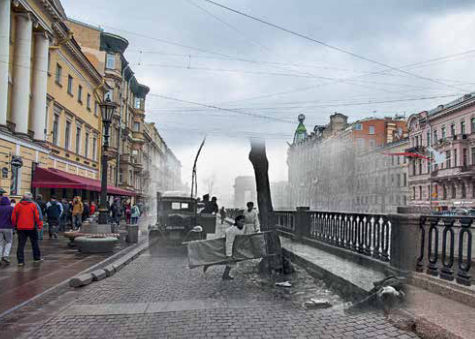
About 1.4 million people, of which about 1.1 million were Jews , were killed A MEDIC RUSHING TO HELP A WOUNDED MAN AT HOUSE NO. 10 AT GRIBOYEDOV CHANNEL One of the most well-known and dramatic images of the Siege. The Luftwaffe ended their massive air raids on the city in December 1941, but German artillery shelled the city every day. Danger of being killed or wounded at any moment was part of everyday life in besieged Leningrad.
Image 4: ADAMINI HOUSE. MOIKA EMBANKMENT, 1 — CORNER OF REVOLUTION STREET:
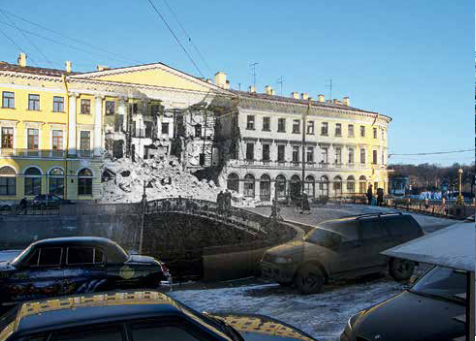
VICTIMS FIELD MPVO report:November 26, 1941 at 13.20.2 high-explosive bombs. Façade is demolished — 3 floors on the side facing Moika collapsed. 4 floors collapsed on the side of Revolution Victims Field. There is a threat of collapse of the building’s columns. Driveway at Bolshoy Konyushenny Bridge is blocked with debris.Casualties: 15 wounded.
Image 5: BODY OF DECEASED RESIDENT OF LENINGRAD AT SAVIOUR ON THE BLOOD CHURCH.
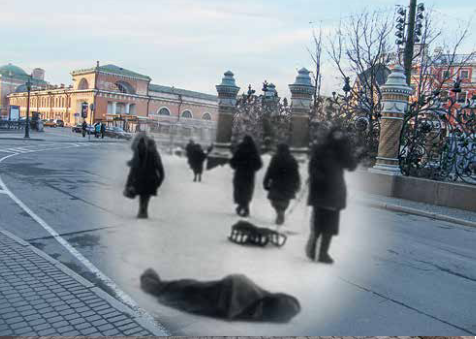
First deaths caused by hunger were recorded in the besieged Leningrad as early as November 1941, while in December 1941, January, February, March 1942 mortality from hunger became a mass phenomenon. Exhausted relatives often did not have energy to transport bodies of deceased family members to a cemetery or a morgue. For this reason one could see bodies of deceased civilians abandoned in the streets.




